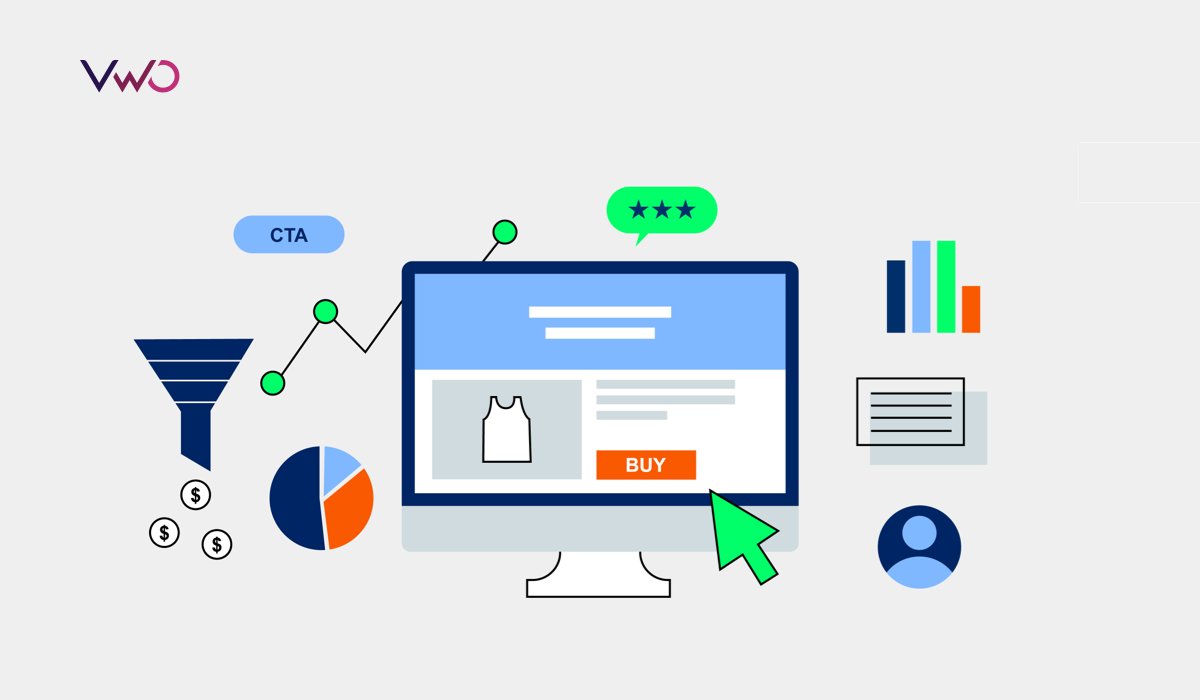Budgeting for CRO: Why You Need To Set Aside a Budget and How To Create One
Conversion Rate Optimization (CRO) is still under-prioritized at many companies and is often the last, sometimes even neglected, marketing investment. However, omitting CRO from your marketing strategy means you’re assuming that acquiring new users is more geared to ROI as compared to maximizing your existing base – whereas, in reality, your user base is already available for conversion to actual revenue.
Even though the outcome of SEO and Pay-per-click ads can be quantified more easily, and the true impact of CRO only shows over time, CRO should be prioritized. This is because not optimizing your website could eventually push back your SEO and PPC efforts too. If you cannot convert your visitors into customers, you are not doing justice to your brand and traffic spend. Without CRO, you also run the risk of focusing on vanity metrics and lose money due to lost opportunities and conversions. Besides, your decision-making around website updates, if not conversion-focused, can end up costing the company too.
Download Free: Advanced CRO Program Guide
Rutger Kühr, Head of CRO at Pricewise, says,“CRO is not just about getting the golden nugget of a 20% uplift, but also about preventing bad ideas from going live”.
Rutger believes that while it could work differently for different companies, without CRO, any change in eCommerce is a gamble.Despite this, many companies still do not set aside money specifically for CRO. Also, those starting to understand its importance might not know how to budget for it. If they spend on CRO at all, the funds are likely to be drawn from a shared marketing pot. Having worked with thousands of brands, at VWO, we’ve realized that many companies struggle to transition from this shared budget, where CRO is not a priority. Hence, we want to demystify the CRO budgeting process for you.
In this guide, we share our findings providing an actionable framework with real-world insights.

What are the benefits of creating a dedicated CRO budget?
Budgeting for CRO generally means you are looking at either hiring an agency or investing in bringing CRO in-house.
Here are some common benefits of creating a separate CRO budget:
- You can hire dedicated staff or an agency to run tests. Dedicated staff can coordinate with other departments allowing for a CRO strategy that aligns better with overall goals.
- If you have the budget to hire a dedicated CRO Manager, you can create a robust CRO testing roadmap.
- You are not fighting for funding against other marketing functions.
“To us, it’s just as important to spend on CRO as it is to spend on our advertising or our creatives”, says Harry Cederbaum of Twillory eCommerce company.
Rutger from Pricewise puts forth the perspective of flexibility to this. Though a staunch advocate of CRO, he does not agree with attaching a specific number to it.
“If you put aside a fixed amount for CRO, you’re probably missing out on potential opportunities outside of that amount”, he says.
What constitutes the budget for CRO?
Here are four of the main categories that you must consider within your CRO budget:
Human capital
Human capital is likely to be the highest cost as a proportion of your budget. Human capital costs include the cost of your existing staff spending time on, or any new team members hired, to meet your CRO objectives. It also includes fees for external consultants or agency teams, if you’re using them.
Building an in-house team (it is unrealistic to combine all required skills into a single role) usually costs a lot more than outsourcing your CRO program to an agency. If you do opt for building a team of experts, you would ideally need at least one specialist each in the area of project management, strategy, UX design, data science, and front-end development. Even a conservative estimate of the team’s total compensation would fall at nearly half a million dollars annually.
Hiring a digital marketing agency to run your CRO program can cost you in the range of $3k/month up to $9k/month. If you choose to get a freelance CRO practitioner on-board, you tend to pay them $10/hour to $400/hour, depending on the level of expertise. The other alternative is hiring a specialized CRO firm – the top ones can cost you around $16k/month, but you can also find some of the smaller ones charging approx. $3k/month to $5k/month.
Tool cost

Alongside staff costs, you’ll also need to consider the cost of any tools or equipment you need. Tool costs will depend on the providers you use and the features you require.
On average, companies spend nearly $2,000 a month on CRO tools. The tools available in the market can be evaluated based on your requirements at each stage of the CRO journey – research, hypothesis, prioritization, testing, and learning. If you’re a beginner in CRO, there are free tools with basic features that can give you a headstart. Depending on your level of CRO maturity, you can also choose a single, integrated tool like VWO for all your optimization needs. VWO comes with an all-inclusive and guided 30-day free trial that you can opt for to try the tool for yourself. Alternately, you can request for a demo of the tool that explains all features in detail.
Harry from Twillory explains how decisions around acquiring a new tool are based on reviews in their company.
“If we are considering a new tool like VWO, for instance, we have a review for whether we want to invest in it. We are a bootstrapped company and don’t have VC money to spend, so our decisions are usually based on reviews”, he says.

Opportunity cost
Opportunity cost refers to revenue lost as a result of the choices not made.
CRO helps you identify the best call-to-action (CTA). In the period when your website runs with the lower performing CTA, you are incurring an opportunity cost.
For example, if you decide to use CTA Option 1, you lose the potential sales you would have gained using CTA Option 2. If Option 1 is less successful, you have incurred an opportunity cost during the period CTA 1 was run.
Once a winning variation is identified, it takes time to deploy it on the website. There is a cost associated with the time lapse between testing and implementing a winning idea. What you need to bear in mind though, is that A/B testing is an important part of the CRO process. What it essentially does is prevents you from making changes to your website that don’t improve conversions and implementing ideas that could potentially damage conversions.
Take a free trial with VWO and start A/B testing your website for improved conversions.
Experimentation regret
During any test, one version will perform better than the other, however small or sizable this difference may be. If the variation performs better than the control, the overall performance of your website will be better than the status quo. Experimentation regret, on the other hand, is if the variation happens to perform worse than the status quo, therefore resulting in an overall decreased website performance.
When you create your CRO budget, aim to strike a balance between highlighting potential issues and focusing on the potential benefits.
Does a CRO budget fit into your current needs?

Before you go any further, consider whether a budget is right for your needs at this time.
According to Rohit Dey, Optimization Consultant & Sales Head North America at VWO, clients start thinking about budgeting for a CRO service when typically one of these two things happen:
- They’ve started acquiring traffic through paid mediums and they understand the composition of this traffic along with the conversion rate for each of these traffic mediums. Now they want to see an ROI on it.
- They are reiterating their design philosophy i.e. taking major design decisions that they need to validate and make sure that they impact conversion rates positively.
Rohit also believes that a lot of organizations are realizing that analytics, by itself, is not enough.
“Analytics gives the answer to ‘what is the problem on your website’, but does not explain the ‘why’ of it. Getting to the solution for the problem requires a hypothesis, which in turn needs research and data. Organizations look for CRO services for this”, he says.
How to prepare your CRO budget

If you’re preparing a budget for CRO activities, it means you’re convinced that these activities will impact your bottom line positively. But you need to convince your management on this too (more on how to do this in the coming sections). If everyone is on board with the idea that the resources required are worth the end goal, budgeting should be a smooth process for you.
Start with calculating your lead value. If your average lead value is $5, and you’re generating 5,000 leads every month, you know you can set aside less than or equal to approx. $25,000 for setting up CRO tools, and a team. As your lead value increases, you can consider increasing your CRO budget too. Likewise, if an A/B testing tool costs less than the lead amount it generates, you can go ahead and purchase it.
Rutger from Pricewise says, “It depends on the tool you’re using and where you’re storing results. For instance, client-side testing can be done in-house with developers but would be more expensive for us than using a tool”.
There could be some tools and talent already within your organization that you could maximize for CRO. It’s a good idea to scope the projected use of these in your budget.
Set conversion goals in your budget that circle back to quantifiable, profitable returns for your company. Calculate your present conversion rate to determine a baseline and set benchmarks for the tests you’re committing to in your budget.
According to Alan at ClickThrough Marketing, it typically takes 10-14 months to see a good ROI and actionable learnings from CRO experiments. So you’d want to start with an annual budget that allows you sufficient time to test your ideas and analyze the outcomes.
Based on your specific reason for investing in CRO, you can create a budget and build a CRO test case that aligns with your goals.
What you need to be mindful of is that demonstrating value early on in your CRO journey is very important. Without that, getting a budget sanctioned in the future may not be possible. To get early results, make sure you scope for and focus on experiments that don’t require a lot of development work or occur on low-traffic pages, hence slowing down your testing velocity. VWO’s Bayesian-powered stats engine, SmartStats, enables you to conclude tests faster and more accurately.
Take a free trial with VWO to improve your testing velocity.
Download Free: Advanced CRO Program Guide
How to decide if you should use an agency or an in-house team

One of the most significant decisions you will make as you draw up your budget is whether to hire a CRO agency or manage your campaign in-house, and the right choice will depend on your company and your needs. There are numerous considerations to make.
First, consider the skills and capacity within your existing marketing team. How much do they know about CRO? Companies with a strong marketing team that already understand CRO might consider directing existing staff time towards the process rather than hiring a new person or bringing in an agency. However, this may not be a good idea in the long term. The skills needed for nailing CRO are wide and deep, and many marketing teams might not have the required knowledge of say, statistics, psychology, or user research. The question then would be if you’re willing to spend considerable time to upskill your existing pool of resources, or use an agency.
You can start with a smaller budget focusing on those low-cost, high-reward options we mentioned earlier. Just keep in mind that CRO can fail if you don’t have the right person for it in-house. Something as simple as not knowing when to conclude a test can damage your position to get further buy-in for CRO from the management.
Also, hiring is expensive. As mentioned before, putting together even a small team of specialists would cost more than what many companies, particularly smaller businesses can afford.
For this reason, it may make more sense for small businesses and newer companies to start out by working with an agency.
Here are some of the benefits of working with an agency:
- Shorter project-initiation times. Hiring a new team member and getting started can take weeks or months, whereas a project with an agency can be initiated in a matter of days.
- Greater flexibility.
- Smaller upfront budget commitment.
- Shorter-term financial burden.
- Strategic experience in experimentation and building a testing culture so you get the ROI needed to convince stakeholders.
- A wide range of expertise in different areas that would prove very expensive to achieve in-house.
- An unbiased approach to conducting research.
Working with a CRO agency can cost anything from $5,000 to $16,000 per month as mentioned earlier, depending on your project’s size, complexity, and the velocity of testing you opt for.
Another option for companies is to start their CRO journey with an agency and transition in-house when the timing is right. Agencies are equipped to help companies build and run an in-house program. Also, your CRO program does not end when your contract with the agency ends, it makes sense to use the agency when extra resources are needed or for help to resolve specific challenges. Therefore, the options need not necessarily be mutually exclusive.
Here are some benefits of bringing CRO in-house:
- An in-house team will be focused solely on your business, as opposed to having multiple clients.
- An in-house team can work out more cost-effectively if you are dedicated to CRO as a permanent business function.
- In-house staff can get to know your business best.
- Stronger opportunities for collaboration between teams.
The team associated with each business unit works closely together to share best practices, monitor progress, and fix anything that isn’t working. With CRO specialists entrenched in the company, they can operate in an agile fashion, planning on a month-to-month basis with an eye on the long-term goals and overall KPIs.
An in-house CRO team can be structured around 3 models depending on your company size, CRO budget, and metrics: centralized, decentralized, and center of excellence (COE). Centralized teams focus on developing long-term optimization strategies and have localized expertise within the team. Decentralized teams have responsibilities distributed among team members across departments. The COE model utilizes a combination of centralized and decentralized approaches. Each model has its own set of advantages and disadvantages, so figuring out which one works best for you is important. One final aspect that you might consider as you make your decision around hiring is your average order value.
Alan at Clickthrough says, “if the average order value for a website is high, then [an agency’s] capability to get that return on investment is much greater”.
Creating a proposal and making a compelling case for CRO
Before you begin constructing your proposal, there is some critical information you will need to gather.
- What is the current conversion rate on your website and how is it being measured?
- How does your company currently define conversion? Which important actions is it aiming for visitors to perform?
- What is your maturity level compared to others in your segment?
- Which tools do you currently use to manage your website and analyze its performance?
- Who are the important stakeholders, and who are the people you need to liaise with on an ongoing basis for the CRO program to work effectively?
Once you have this information in place, create a proposal that incorporates the following:
- Your explanation of what CRO means and how it will improve the business.
- Your conversion goals and how you will measure them.
- The process you will follow to achieve the goal in terms of audit, action, and reporting.
- The existing resources that you will need access to; both tools and talent.
- The cost of planned CRO activities bundled in an easy-to-consume package.
- The expected outcome and ROI.
If you’re bent towards hiring an agency, you will most likely receive such a proposal from their side. If you’re considering CRO in-house, you will need to create one.
In either case, each of the proposal elements should focus on the company’s benefit. The proposal should clearly articulate how the CRO goal of getting more visitors into the sales funnel will be achieved. Rohit from VWO explains that an agency’s focus during the proposal stage is to help the client understand that CRO is a process, it would take 6-12 months for a successful CRO program to
yield results, and what a projected uplift in conversion rate would mean for the client in terms of say, gross sales or number of leads.
“We focus on the ROI, and then justify the investment in the CRO program. We also focus on learnings – we don’t say every experiment will be a winner but there will be a learning in each experiment”, Rohit says.
As a follow-up to the proposal, many companies also present a business case to the senior management highlighting specific financial details of the budget. For instance, considering your current traffic and conversion rate, how much an X% increase in a particular metric could drive in terms of revenue, how it could make paid campaigns more profitable, or allow you to spend an additional X amount of money into ads to scale your business.
Navigating the proposal process
The proposal process is likely to include the following steps:
- Generating buy-in from relevant team members.
- Getting support from the Head of Marketing (or equivalent).
- Running test cases and gathering data.
- Creating your proposed budget.
- Presenting your proposal to the Board or C-suite.
- Answering questions about your proposed project. You’ll need to show you have thought through the possible risks and taken steps to manage them.
- Possibly refining your proposal or providing more information, if required.
If you use a financial justification for CRO, present specific numbers and robust data at every stage of the process to support your case.
“Associate CRO to one lever in the organization – whether it’s UX, financial, or operational. Explain what an un-optimized form means for say, an insurance provider. What does the loss of conversion look like in terms of revenue loss?”, Rohit from VWO explains.
Often, focusing on the negative can get you the buy-in you need. You could stress on something like – CRO will get you a 10% uplift (which is very tough to predict in the first place) – or you could show how bad UX will create a negative brand image. The latter could prove to be more effective.
How to design an initial test case that builds buy-in

A test case is a set of actions designed to prove a hypothesis – in this case, that CRO matters and is worth the investment. Your test case should be low risk and high reward. In other words, the investment cost in time or money should be minimal, while the outcome will help either decrease cost or increase earnings.
You will need to design a simple experiment and establish a framework of trackable KPIs to demonstrate the outcome. Focusing on compound annual earnings when measuring success can help. In other words, how much additional revenue are you likely to generate for the next year based on the results of a successful test?
For example, let’s imagine that you design a test case based on changing the layout of your sales page to improve the customer experience. Now let’s further imagine that this change brings in a 5% increase in conversion rate. That number might sound small, but project it out over the next year. What does that small increase in conversion rate mean in terms of annual revenue?
A great test case should have the following characteristics:
- Low cost – both in terms of the financial cost and time.
- Easy to implement.
- Easy to replicate or re-run if necessary.
- Controlled for other variables. For example, don’t run your CRO test on Black Friday when your revenue increase can be easily attributed to the sale instead of your CRO efforts.
- In addition, you should consider the long-term potential (or lack thereof) for a test and result. Alan at Clickthrough told us about a test he ran using the “dark mode” on Apple’s iOS system. Though the initial results were promising, he noted that they likely wouldn’t last. “Those results are likely to be short-lived because dark mode was a trend”, Alan says.
There are numerous test cases you could run, but the important thing is to start with research or user insights and identify the low-hanging fruits. Based on your observations, you could formulate a hypothesis around some of the examples mentioned below :
- Changing the wording, color, or placement of your call to action. For example, in one test VWO ran for a client, a simple change to the CTA button yielded a 62% increase in conversions.
- Improving product image quality.
- Adding customer reviews or testimonials to your sales page.
If you ensure your test case meets all the criteria we outlined above (low cost, easy to implement, easy to re-run if necessary, and controlled for external variables) and is based on user insights gained from research tools like heatmaps, you’ll ensure that you present a results-oriented and detailed case for CRO budgeting. If this sounds tricky, you can always get in touch with our experts at VWO for a detailed audit of your website.
Common problems that might sink your budget (and how to avoid them)
With any project, things can go wrong. If you’re the person in charge of the project, the blame will land on your feet. The best way to avoid this is to be aware of the areas that could cause your CRO project to go over budget or identify tests that might fail and mitigate those risks.
Some of the most common budget-sinking problems you should be aware of are:
- Delays. Preventable delays are the biggest cause of project overspend.
- Testing ideas that are based on gut rather than user data; which is likely to lead to failed experiments.
- Incorrect prioritization of hypotheses i.e. the high impact ideas are not tested first.
- Lack of patience to see the first (and regular) “successful” tests.
- Inability to interpret test results correctly, so you don’t know what to do with them – implement or take learnings.
- Incomplete buy-in/support from management/relevant teams you want resources from.
The best way to manage these strategies is to have a clear plan and be aware of what you want to achieve. For instance, you can avoid delays by creating a clear and realistic timeline for the project, with numerous smaller deadlines and check-in points along the way.
In addition, when an experiment fails, or you don’t see the results you wanted, ensure you take the time to learn from them. Every failure teaches you something that will enable you to increase revenue, improve customer experience, or streamline your processes next time.

How to strategically scale your CRO program and increase your budget
CRO is still undervalued in many companies, with senior executives preferring to use their budget for traffic acquisition rather than increasing conversions. To overcome this, you need to demonstrate the value CRO can add. Low-risk, high-reward tests and a strong project proposal and budget are the tools that will allow you to do this.
The trick to a scalable strategy is to build a company culture that values experimentation and sees the value in CRO.
You need to be forewarned with the knowledge that CRO investments tend to go down the path of diminishing returns if not treated wisely. A boost from 1% conversion rate to 2% will generally cost less than a boost from 2% to 4%. You then need to adapt your strategy as your website gets optimized – test bolder ideas and test more broadly throughout the business.
As Alan from Clickthrough Marketing says, “CRO is not cheap, but if you do it well, it pays more dividends than you can hope for. You need to be open-minded and think long-term”.




















